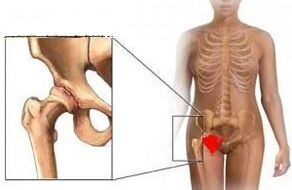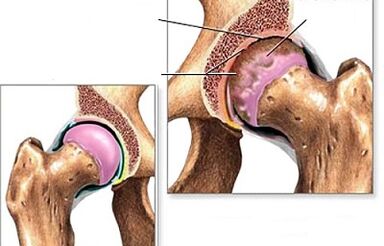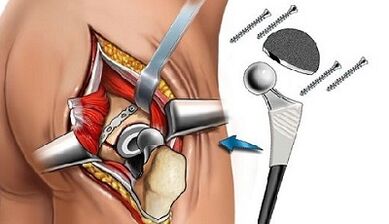
The articularity of the hip joint is a serious pathology that develops in the hip joint due to nutrition, and therefore, the destruction of cartilage tissue and the immobility of the thighs.
In the case of healthy cartilage tissue of the joint, exercise can easily occur without any inconvenience.If the cartilage is damaged by the joint, its surface is no longer smooth, it has Zabina, fossa, making it difficult for normal joint flexion/extension.The thighs become rusty rings of the garden door, and it feels nervous when it moves when it hears the squeaky opening.
The disease is dangerous because as treatment begins, not only is it impossible to cure, but the course of the disease can lead to further movement and joint loss.
reason
What's this?Coksartrosis develops for a number of reasons, mainly a sedentary lifestyle.Most of the time, athletes suffer from this disease due to the huge load that can hurt the joints.Unfortunately, arthritis is often hereditary, and congenital dislocation in the inguinal area is possible.
Causes of the development of hip coksartrosis:
- disease;
- fracture of the thigh neck;
- Injured or micro-crowned in childhood.
- Too much weight and high load;
- drink wine;
- Congenital disease;
- Increased hormone levels (age-related changes);
- Tissue inflammation;
- Destruction of joint tissue;
- Take effective drugs;
- A stressful situation;
- infectious and inflammatory processes;
- Pathological thigh disease in the groin area.
Special attention should be paid to the presence of injuries (Microma).They heal for a long time, which leads to years of development of the disease.Most commonly, the disease begins to develop in people aged 40 and older.Inflammation starts with one hip joint, but if you don't treat it promptly, the disease applies to other areas.
Symptoms of hip arthritis

People over the age of 40 develop the most frequently.It gradually develops, and a person's condition deteriorates every year.If you do not deal with damaged joints, there may be pathological changes in another joint afterwards.
In world practice, it is recognized that arthritis in the hip joint has three stages or developmental stages.Each of them has their own symptoms.
1 degree joint
At this stage of the disease, a person will experience pain only when physically exhausted and later, from long running or walking, the main joints themselves will be damaged and rarely cause pain to the thighs or knees.
Similarly, at the same time, a person's gait is normal, no chroma is observed, and the hip muscles do not atrophy.At the time of diagnosis of the picture, bone growth was observed, which was located on the inner and outer edges of the acetabular, and other pathological diseases of the femur, no other pathological diseases of the femur were observed.
2 degree joints
With the second degree of jointness of the hip joint, the symptoms become significant, and the pain has gained a more constant and intense nature, both succumbing to the groin and thigh when stationary and moving, and under load, the patient is already shrinking.The thighs are also limited, and the volume of hip movement is reduced.
In the picture, the narrow distance of the gap is normal, bone growth is found on the outer and inner edges, the head of the hip head begins to increase, deform and move, and its edges become uneven.
3-degree joints of the hip joint
At this stage of the disease, the pain is inherently painful, and it is difficult for the patient to move independently, whether day or night, so using crutches or crutches, the volume of joint movement is very limited, and the muscles, hips and hips in the lower leg are atrophy.
The legs are shortened, and when the person walks toward the sick leg, the person is forced to lean his body.The load on the damaged joint increases due to the displacement of the center of gravity.In the X-ray pictures, multiple bone growths, thigh heads swell and significantly narrowed joint spaces were found.
diagnosis
The diagnosis is based on anatomical data (identification of risk factors or causal diseases), clinical data and other examination methods.

To clarify the diagnosis and perform differential diagnosis will help:
- X-rays of the hip joint;
- Ultrasound of joints;
- MRI or CT.
Typically, accurate diagnosis is established, sufficient clinical and radiological examinations are provided.On X-rays, specific changes in each stage of the disease were found: stenosis of joint space, the presence of bone plants, displacement and deformation of the femoral head, subchondral cyst and peripheral bone intradural surgery, bone bone changes.The degree and stage of the disease are established based on the existence and severity of these pathological changes.
Treat hip joints
In the first stage, the joint nature of the hip joint is completely suitable for conservative treatment.The crucial task is to relieve pain and thus prevent the patient from moving.
In the process of competing therapy,:
- Restore nutrition and blood circulation in muscles and cartilage;
- Reduced physical activity in damaged joints;
- Repair damaged cartilage;
- Activation of hidden reserves in the body, which will lead to tissue regeneration at the microcell level;
- Increased joint space;
- Restore joint mobility.
During drug treatment, patients in this category prescribe the following medications:
- Nonsteroid anti-inflammatory.They will help eliminate pain, eliminate edema and inflammation formed, but their uncontrolled use will help suppress the natural possibility of cartilage.Doctors do not recommend using multiple nonsteroid drugs at the same time;
- Relaxed muscles.Removes muscle cramps and increases blood supply to the joints, but their use should be used under the supervision of a doctor due to side effects;
- Expanded vessel.They are able to relax smooth muscles and increase space between muscles.The least contraindications, but their effectiveness is an individual indicator;
- Steroid type.Helps with diseases such as inflammation of the thigh bone, but has many side effects;
- Restore cartilage.Cartilage protectors are most useful in healing joints.They feed on the elements they need and stop the disease from developing.
- Local use.The main positive effect is to rub the product into the skin, thereby reducing muscle cramps and helping improve blood circulation.
During conservative treatment, patients should adhere to their diet and be designed specifically for hip joint patients.The course of therapeutic therapy includes therapeutic massage, which is shown as a patient with stage 1 and 2 of arthritis.
Opthetics

The third stage of the disease is only suitable for surgical treatment.It is recommended to use patients to replace joints or endoplants.The surgeon cuts the bones of the thighs, inserts the metal pin into the incision, and secures the artificial head on it.
The prosthesis itself is a single rod (replaces the head only) and a total (replaces the two components).The day after the surgery, some elements of exercise therapy were performed on the recliner on the bed, and the patient might stand up, but there was no support on his legs a few days after the crutch.After 2-3 months, a cane will not be needed and the legs will be allowed to be fully loaded.
Patients who receive OP drinks are advised to undergo rehabilitation, including physical therapy exercises, massage classes and physical therapy.In most cases, limb function will be restored.The prosthesis has a service life of 10 to 20 years and is then replaced.
Gymnastics for hip arthritis
Exercises to work hard and prevent COKSARTROSIS must be carefully performed.Exercise therapy should exercise smoothly and not cause pain.The LFK used to treat the disease should be designed primarily to strengthen the muscle itself, rather than loading the joints.A good way to prevent coksartrosis is to swim, especially in salt water.
- Starting position: Lying on the floor, stretching your arms and legs along your body.Slowly, lift the sore legs up and straighten them in the knee joint 15 cm from the floor, keeping it for about half a minute.After that, lower your leg and repeat the movement with the other foot;
- Starting Position: Lying on your stomach, legs and arms stretching along your body.Lift straight legs 15 cm high, make, and spread them to the sides.Everything should be done slowly.
Patients should remember that some hip joint exercises with exercise therapy can be difficult due to physical exercise.They are very effective ways to prevent a variety of diseases and are therefore included in the motor treatment system for joint diseases and other diseases.
Folk therapy
In folk medicine, there are many successful treatments for coxhropis:

- tin agents and debris used inwardly (there are many recipes for preparing cured folk medicines, including garlic, lemon, mummy and various parts of the plant as well as honey, etc.);
- ointments based on various natural ingredients (oints made from Celandine, Eucalyptus Oil, Aloe and other plants);
- Compress and bathtub (imposed cabbage slices, bath with Jerusalem artichokes, etc.).
With all civil remedies, it is important to remember that there is no guarantee of 100% recovery.
prevention
Preventive measures are very important, especially if you have a history of hip joints, fractures, strong bruises or suppurative processes.
- Weight control (reduce dietary use of flour products, meal salt, sweet tea and coffee).With overweight, the risk of hip joints increases.
- Weight transfer, jump (especially height).Try not to stand up for a long time.
- If there are diseases related to metabolism (diabetes, atherosclerosis), they must be compensated.
- Sports designed to strengthen hip and hip muscles (cycling or cycling, swimming, therapeutic gymnastics).
Adhering to preventive measures, early detection of coronary heart disease and its adequate treatment is key to the positive prognosis of the disease.























